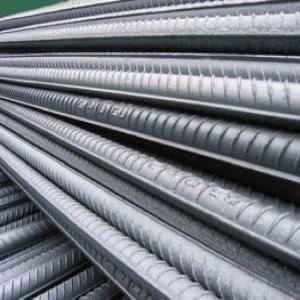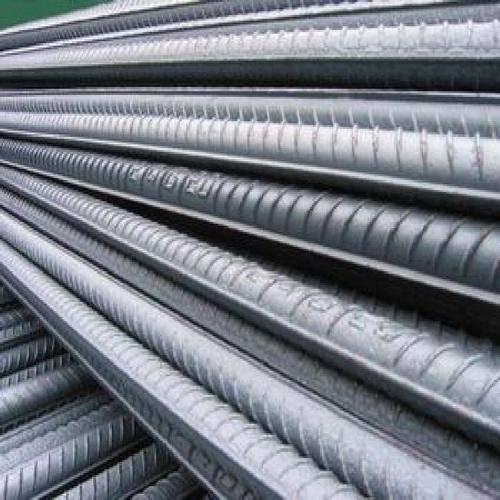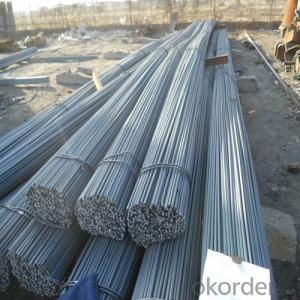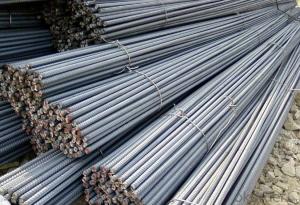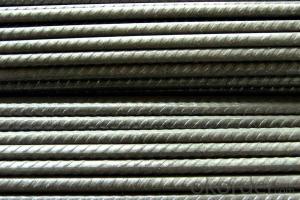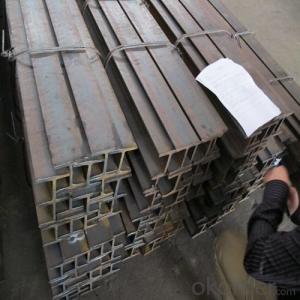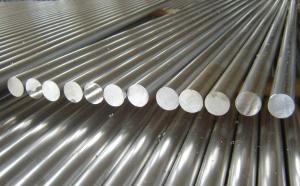Deformed Bar HRB335 HRB400 Hot Rolled High Quality 6mm-50mm
- Loading Port:
- China Main Port
- Payment Terms:
- TT or LC
- Min Order Qty:
- -
- Supply Capability:
- -
OKorder Service Pledge
OKorder Financial Service
You Might Also Like
Product Description:
OKorder is offering Deformed Bar HRB335 HRB400 Hot Rolled High Quality 6mm-50mmat great prices with worldwide shipping. Our supplier is a world-class manufacturer of steel, with our products utilized the world over. OKorder annually supplies products to European, North American and Asian markets. We provide quotations within 24 hours of receiving an inquiry and guarantee competitive prices.
Product Applications:
Deformed bar is widely used in buildings, bridges, roads and other engineering construction. Big to highways, railways, bridges, culverts, tunnels, public facilities such as flood control, dam, small to housing construction, beam, column, wall and the foundation of the plate, deformed bar is an integral structure material. With the development of world economy and the vigorous development of infrastructure construction, real estate, the demand for deformed bar will be larger and larger
Product Advantages:
OKorder's Deformed Bar HRB335 HRB400 Hot Rolled High Quality 6mm-50mm are durable, strong, and resist corrosion, exact size, regular package, chemical and mechanical properties are stable.
Main Product Features:
· Premium quality
· Prompt delivery & seaworthy packing (30 days after receiving deposit)
· Corrosion resistance
· Can be recycled and reused
· Mill test certification
· Professional Service
· Competitive pricing
Product Specifications:
Manufacture: Hot rolled
Grade: BS4449
Certificates: ISO, SGS, BV, CIQ
Diameter: 6mm,8mm,10mm,12mm,14mm,16mm,18mm,20mm,
22mm,25mm,28mm,32mm,36mm,40mm,50mm
Length: 6M, 9M,12M or as required
Packaging: Export packing, nude packing, bundled
Chemical Composition: (Please kindly find our chemistry of our material based on HRB500 as below for your information)
Grade | Technical data of the original chemical composition (%) | ||||||
C | Mn | Si | S | P | V | ||
HRB400 | ≤0.25 | ≤1.60 | ≤0.80 | ≤0.045 | ≤0.045 | 0.04-0.12 | |
Physical capability | |||||||
Yield Strength (N/cm²) | Tensile Strength (N/cm²) | Elongation (%) | |||||
≥400 | ≥570 | ≥14 | |||||
Theoretical weight and section area of each diameter as below for your information:
Diameter(mm) | Section area (mm²) | Mass(kg/m) | Weight of 12m bar(kg) |
6 | 28.27 | 0.222 | 2.664 |
8 | 50.27 | 0.395 | 4.74 |
10 | 78.54 | 0.617 | 7.404 |
12 | 113.1 | 0.888 | 10.656 |
14 | 153.9 | 1.21 | 14.52 |
16 | 201.1 | 1.58 | 18.96 |
18 | 254.5 | 2.00 | 24 |
20 | 314.2 | 2.47 | 29.64 |
22 | 380.1 | 2.98 | 35.76 |
25 | 490.9 | 3.85 | 46.2 |
28 | 615.8 | 4.83 | 57.96 |
32 | 804.2 | 6.31 | 75.72 |
36 | 1018 | 7.99 | 98.88 |
40 | 1257 | 9.87 | 118.44 |
50 | 1964 | 15.42 | 185.04 |
FAQ:
Q1: Why buy Materials & Equipment from OKorder.com?
A1: All products offered byOKorder.com are carefully selected from China's most reliable manufacturing enterprises. Through its ISO certifications, OKorder.com adheres to the highest standards and a commitment to supply chain safety and customer satisfaction.
Q2: How do we guarantee the quality of our products?
A2: We have established an advanced quality management system which conducts strict quality tests at every step, from raw materials to the final product. At the same time, we provide extensive follow-up service assurances as required.
Q3: How soon can we receive the product after purchase?
A3: Within three days of placing an order, we will begin production. The specific shipping date is dependent upon international and government factors, but is typically 7 to 10 workdays.
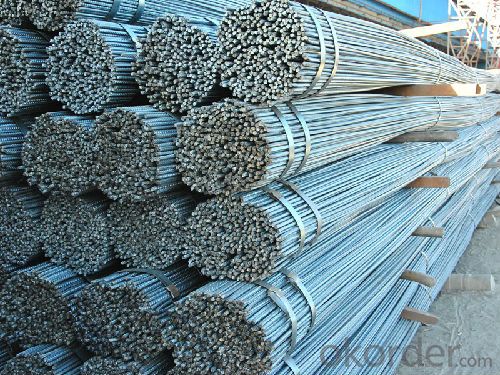
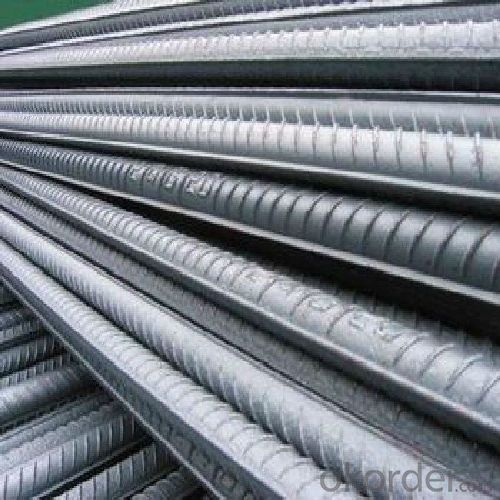
- Q: What are the weight and density of steel rebars?
- Steel rebars, also known as reinforcing bars, are commonly used in construction to provide tensile strength to concrete structures. The weight and density of steel rebars can vary depending on their size and grade. The weight of a steel rebar is determined by its cross-sectional area and the specific weight of steel, which is approximately 7850 kilograms per cubic meter (or 0.2836 pounds per cubic inch). The cross-sectional area is typically measured in square millimeters or square inches. For example, a common size of steel rebar is the #4 bar, which has a diameter of 12.7 millimeters (or 0.5 inches) and a cross-sectional area of 127 square millimeters (or 0.197 square inches). Using the specific weight of steel, we can calculate the weight of a #4 rebar as follows: Weight = Cross-sectional area x Specific weight of steel Weight = 127 mm^2 x 7850 kg/m^3 Weight = 998,950 grams or approximately 998.95 kilograms (or 2,201 pounds) In terms of density, the density of steel rebars is the same as the specific weight of steel, which is approximately 7850 kilograms per cubic meter. This density is relatively consistent across different sizes and grades of steel rebars. It is important to note that the weight and density of steel rebars can vary slightly depending on the specific composition and manufacturing process. Therefore, it is always recommended to refer to the manufacturer's specifications or consult engineering references for accurate and up-to-date information.
- Q: How are steel rebars connected or joined together?
- Steel rebars are commonly connected or joined together using different techniques such as overlapping, welding, mechanical splicing, or using couplers. These methods ensure a strong and secure connection between the rebars, enhancing the structural integrity of reinforced concrete elements.
- Q: Are steel rebars suitable for use in structures with high vibration levels?
- Steel rebars are commonly used in structures with high vibration levels. The strength and durability of steel rebars make them suitable for such applications. When structures are subjected to high vibration levels, the rebars help to provide stability and prevent any potential damage or failure. Steel rebars have excellent tensile strength, which enables them to withstand the dynamic forces generated by vibration. Additionally, steel rebars have good ductility, allowing them to absorb and dissipate energy during vibrations, thereby reducing the risk of structural damage. Proper design and installation techniques, including the use of appropriate reinforcement detailing, can further enhance the performance of steel rebars in structures with high vibration levels. Overall, steel rebars are a reliable choice for ensuring the structural integrity and safety of buildings and infrastructure exposed to significant vibrations.
- Q: Can steel rebars be used in sound barrier walls?
- Yes, steel rebars can be used in sound barrier walls. Steel rebars are commonly used in the construction of reinforced concrete structures, including sound barrier walls. These rebars provide strength and durability to the walls, ensuring they can withstand the forces exerted on them by wind, weather, and impacts. Additionally, steel rebars help to enhance the structural integrity of the sound barrier walls, making them more resistant to vibrations and noise transmission. Therefore, steel rebars are a suitable and commonly used material in the construction of sound barrier walls.
- Q: What is the role of steel rebars in load-bearing structures?
- The role of steel rebars in load-bearing structures is to provide reinforcement and increase the overall strength and durability of the structure. Steel rebars are embedded within concrete to enhance its tensile strength, as concrete alone is weak in tension. By distributing and resisting the applied loads, rebars help prevent cracks and failures, ensuring the stability and longevity of the load-bearing structure.
- Q: What is the process of calculating the required quantity of steel rebars for a project?
- The process of calculating the required quantity of steel rebars for a project involves several key steps. Firstly, you need to determine the design requirements and specifications of the project. This includes understanding the structural drawings, plans, and any relevant building codes or regulations. Next, you need to identify the specific areas where steel rebars will be used. This can include foundations, columns, beams, slabs, and any other structural elements that require reinforcement. Once the areas are identified, you need to calculate the total length of rebars required for each element. This is done by measuring the dimensions of the elements and determining the required spacing and overlap of the rebars. After obtaining the lengths, you need to consider the bar diameter and spacing requirements, as specified in the design. This will help you calculate the number of rebars needed for each element. In addition to the length and number of rebars, you also need to consider wastage and additional reinforcement requirements. It is common practice to add a percentage of wastage (usually around 2-5%) to account for cutting and bending of the rebars. You may also need to add extra bars for special conditions or to meet the design requirements. Finally, you should create a detailed bar bending schedule (BBS) that includes all the necessary information such as bar sizes, lengths, shapes, and placement details. This schedule acts as a guide for the construction team during the installation process. It is important to note that the process of calculating the required quantity of steel rebars may vary depending on the complexity and size of the project. It is recommended to consult with a structural engineer or a professional rebar detailer to ensure accurate calculations and adherence to the project's specifications.
- Q: What is the effect of corrosion on the strength of steel rebars?
- Corrosion has a detrimental effect on the strength of steel rebars. As corrosion occurs, it causes the steel rebar to rust and deteriorate, leading to a loss of structural integrity. This can significantly weaken the rebars, compromising their ability to support loads and increasing the risk of structural failure. Regular inspection and maintenance are crucial to prevent corrosion and maintain the strength of steel rebars.
- Q: What is the process of threading steel rebars?
- The process of threading steel rebars involves creating threads on the ends of the rebars to allow for easy and secure connection with other rebars or structural elements. This threading process is typically done using a machine called a rebar threading machine. The first step in the process is to prepare the rebars by cutting them to the desired length. Once the rebars are cut, the ends are cleaned to remove any dirt, rust, or debris that may interfere with the threading process. This ensures a smooth and accurate threading operation. Next, the rebar threading machine is set up. The machine consists of a spindle that rotates at a high speed, along with a threading die that is positioned on the spindle. The threading die has grooves and ridges that are designed to cut threads into the rebars. To thread a rebar, one end is inserted into the threading machine, while the other end is held firmly in place. The machine is then started, and the spindle rotates, causing the threading die to cut into the rebar's surface. As the die moves along the rebar, it creates threads by removing small amounts of material. The machine is operated until the desired length of threads is achieved. The length of threads can vary depending on the specific requirements of the project and the type of connection being made. It is crucial to ensure that the threads are cut accurately and consistently to maintain the structural integrity of the rebar connections. Once the threading process is complete, the threaded rebars are inspected to ensure that the threads are clean, free from defects, and meet the required standards. The threaded rebars are then ready to be used in construction projects, where they can be connected to other rebars or structural elements using various methods such as couplers or nuts. In summary, the process of threading steel rebars involves cutting and cleaning the rebars, setting up a rebar threading machine, inserting the rebars into the machine, and using a threading die to cut threads into the rebars. This process ensures that the rebars can be easily and securely connected in construction projects, providing strength and stability to the structures they are used in.
- Q: What are the guidelines for proper handling and disposal of steel rebars on construction sites?
- Here are the revised guidelines for the correct handling and disposal of steel rebars on construction sites: 1. Handling: - It is important to wear the appropriate personal protective equipment (PPE) such as gloves and safety glasses when handling steel rebars. - To prevent injuries, make sure to lift and carry the rebars correctly, using your legs and not your back. - Avoid throwing or dropping rebars as this can cause damage to the surrounding area and potentially harm workers. 2. Storage: - Rebars should be stored in a designated area that is easily accessible and away from traffic or other hazards. - To prevent them from rolling or falling, stack the rebars vertically. - Organize the rebars using racks or shelves to avoid tangling or damage. 3. Disposal: - Properly dispose of damaged or unusable rebars. - Contact local waste management authorities to understand the specific disposal requirements for steel rebars in your area. - Consider sending the rebars to a recycling facility if recycling is available, to reduce waste and promote sustainability. - Avoid disposing of steel rebars in regular trash bins or open areas, as they can be a safety hazard. 4. Transportation: - When moving rebars within the construction site or transporting them to another location, ensure they are properly secured to prevent falling off the vehicle or causing damage. - Use appropriate vehicles, such as trucks or trailers, with sufficient tie-down points for proper transportation. 5. Training and Communication: - Ensure that all workers involved in handling and disposing of steel rebars receive adequate training on the guidelines and safety procedures. - Clearly communicate the guidelines to all workers, including subcontractors or temporary workers, to ensure consistent adherence to the rules. - Regularly review and update the guidelines as needed to address any evolving safety concerns or regulatory changes. By adhering to these guidelines, construction sites can create a safe and organized working environment while ensuring the proper handling and disposal of steel rebars.
- Q: Can steel rebars be used in structures with limited accessibility?
- Yes, steel rebars can be used in structures with limited accessibility. Steel rebars are commonly used in reinforced concrete structures to provide strength and durability. They are versatile and can be easily transported and installed even in areas with limited accessibility. In such situations, steel rebars can be cut, bent, and assembled on-site to fit the specific requirements of the structure. Additionally, steel rebars can be prefabricated off-site and then transported to the construction site, allowing for easier handling and installation in areas with restricted access. This makes steel rebars a suitable choice for structures in remote locations or areas with limited space.
Send your message to us
Deformed Bar HRB335 HRB400 Hot Rolled High Quality 6mm-50mm
- Loading Port:
- China Main Port
- Payment Terms:
- TT or LC
- Min Order Qty:
- -
- Supply Capability:
- -
OKorder Service Pledge
OKorder Financial Service
Similar products
Hot products
Hot Searches
Related keywords
